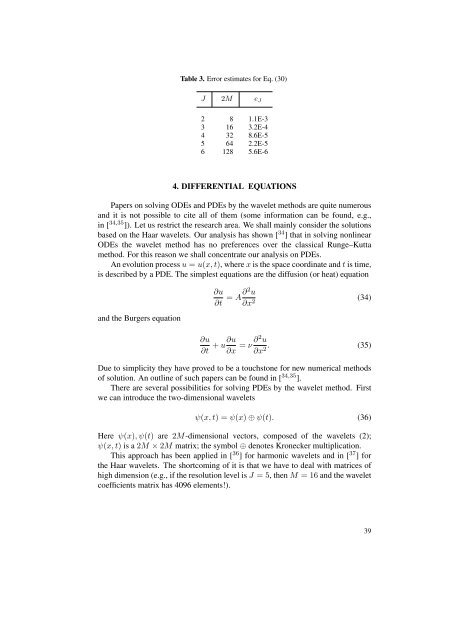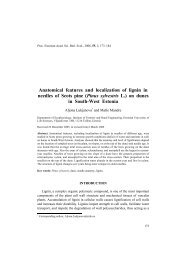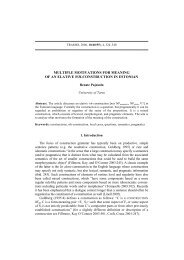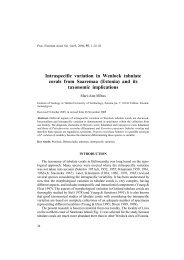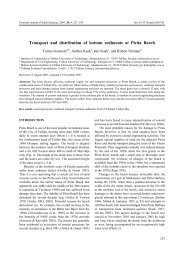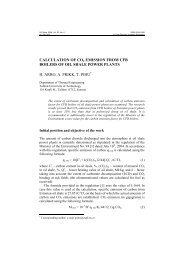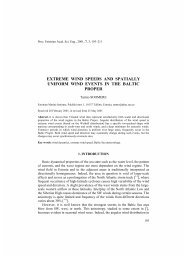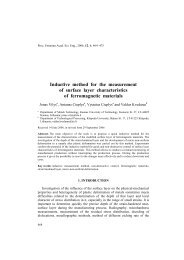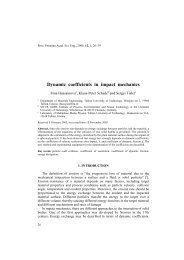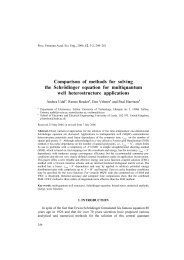Application of the Haar wavelet transform to solving integral and ...
Application of the Haar wavelet transform to solving integral and ...
Application of the Haar wavelet transform to solving integral and ...
Create successful ePaper yourself
Turn your PDF publications into a flip-book with our unique Google optimized e-Paper software.
Table 3. Error estimates for Eq. (30)<br />
J 2M e J<br />
2 8 1.1E-3<br />
3 16 3.2E-4<br />
4 32 8.6E-5<br />
5 64 2.2E-5<br />
6 128 5.6E-6<br />
4. DIFFERENTIAL EQUATIONS<br />
Papers on <strong>solving</strong> ODEs <strong>and</strong> PDEs by <strong>the</strong> <strong>wavelet</strong> methods are quite numerous<br />
<strong>and</strong> it is not possible <strong>to</strong> cite all <strong>of</strong> <strong>the</strong>m (some information can be found, e.g.,<br />
in [ 34,35 ]). Let us restrict <strong>the</strong> research area. We shall mainly consider <strong>the</strong> solutions<br />
based on <strong>the</strong> <strong>Haar</strong> <strong>wavelet</strong>s. Our analysis has shown [ 34 ] that in <strong>solving</strong> nonlinear<br />
ODEs <strong>the</strong> <strong>wavelet</strong> method has no preferences over <strong>the</strong> classical Runge–Kutta<br />
method. For this reason we shall concentrate our analysis on PDEs.<br />
An evolution process u = u(x, t), where x is <strong>the</strong> space coordinate <strong>and</strong> t is time,<br />
is described by a PDE. The simplest equations are <strong>the</strong> diffusion (or heat) equation<br />
<strong>and</strong> <strong>the</strong> Burgers equation<br />
∂u<br />
∂t = u<br />
A∂2 ∂x 2 (34)<br />
∂u<br />
∂t + u∂u ∂x = ν ∂2 u<br />
∂x 2 . (35)<br />
Due <strong>to</strong> simplicity <strong>the</strong>y have proved <strong>to</strong> be a <strong>to</strong>uchs<strong>to</strong>ne for new numerical methods<br />
<strong>of</strong> solution. An outline <strong>of</strong> such papers can be found in [ 34,35 ].<br />
There are several possibilities for <strong>solving</strong> PDEs by <strong>the</strong> <strong>wavelet</strong> method. First<br />
we can introduce <strong>the</strong> two-dimensional <strong>wavelet</strong>s<br />
ψ(x, t) = ψ(x) ⊕ ψ(t). (36)<br />
Here ψ(x), ψ(t) are 2M-dimensional vec<strong>to</strong>rs, composed <strong>of</strong> <strong>the</strong> <strong>wavelet</strong>s (2);<br />
ψ(x, t) is a 2M × 2M matrix; <strong>the</strong> symbol ⊕ denotes Kronecker multiplication.<br />
This approach has been applied in [ 36 ] for harmonic <strong>wavelet</strong>s <strong>and</strong> in [ 37 ] for<br />
<strong>the</strong> <strong>Haar</strong> <strong>wavelet</strong>s. The shortcoming <strong>of</strong> it is that we have <strong>to</strong> deal with matrices <strong>of</strong><br />
high dimension (e.g., if <strong>the</strong> resolution level is J = 5, <strong>the</strong>n M = 16 <strong>and</strong> <strong>the</strong> <strong>wavelet</strong><br />
coefficients matrix has 4096 elements!).<br />
39


